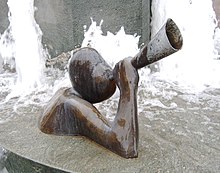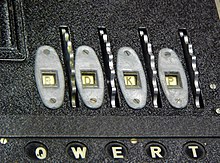Triton (key network)
Triton was the German code name of a particularly important radio key network of the German navy during the Second World War . The British code name for it was Shark ( German " Hai " ). It was used for secret communication between the commander of the submarines (BdU) and the submarines operating on Allied convoys in the Atlantic .
history
Was introduced Triton on October 5, 1941 as a new separate key network for the Atlantic submarines. Patron saint was the sea god Triton ( ancient Greek Τρίτων Trítōn ) from Greek mythology . He is often depicted in art (picture) , blowing on his conch (a snail shell ), stirring up the sea or calming it down again.
The trigger for the introduction were security concerns of the BdU, which was always worried that the enemy might "break into" "his" radio communication to the submarines, which is important for the war effort . As we know today, he was right to fear this. Such a break-in should be prevented by creating a separate key network, exclusively for the war-essential radio traffic to the submarines in the Atlantic.
At the end of 1941, the Enigma-M3 (picture) was used in the Kriegsmarine, especially in the submarines . This essentially corresponded to the Enigma I generally used by the German armed forces in the army and air force . The only significant difference was that on the M3, in addition to the five reels available for selection on the Enigma I, which were numbered with Roman numerals (I, II, III, IV and V), there were three further reels (VI, VII and VIII). were additionally available. From the expanded range of rollers - prescribed by a top secret key board - three different rollers were selected and installed in the Enigma. While 5 · 4 · 3 or 60 roller layers were possible in the army and air force , the M3 of the Kriegsmarine was characterized by a significantly increased combinatorial complexity of 8 · 7 · 6 or 336 possible roller layers. This made unauthorized decipherment difficult and protected Triton . However, the BdU did not know that this was the case for just under a month, until the end of October. As early as November 1941, Shark could be "read" by the British secret service .
However, this changed suddenly when on February 1, 1942, the M3 (with three rollers) in the Triton key network was replaced by the new Enigma-M4 (with four rollers). In addition to the eight available rollers of the M3, three of which were used, there was a new roller for the M4, which was always on the far left of the roller set (picture) , and enlarged it from three to four rollers. The new roller was designed to be narrower than the others for reasons of space and was marked with the Greek letter “β” ( beta ). The submariners called it the "Greek roller". Although this roller could be turned manually to one of 26 rotational positions, in contrast to rollers I to VIII, it did not continue to rotate during the encryption process. Nevertheless, this measure has significantly improved the cryptographic strength of the Enigma.
As a result, Triton could not be deciphered for ten months by the cryptanalysts in Bletchley Park (BP), the central cryptanalysis office located about 70 km north of London . This painful for the British black-out was a phase in which the German U-boat force was able to record again a great success. The submariners called them their "second happy time" .
This only changed after the destroyer HMS Petard landed U 559 in the eastern Mediterranean about 140 km north of Port Said ( Lage ) on October 30, 1942 . Three British sailors, Tony Fasson (1913-1942), Colin Grazier (1920-1942) and Tommy Brown (1926-1945), managed to board the submarine and top-secret code books as short signal stitching and weather short key to, capture . The secret material was taken to Bletchley Park and was instrumental in helping the Codebreakers break the Triton key network . From December 12, 1942, they were able to read the German submarine radio messages again. Nothing changed when the Navy introduced an alternative Greek cylinder "γ" ( Gamma ) on July 1st, 1943 , which could be used instead of the "β".
In this way, the convoys vital to the war in the United Kingdom could be diverted around the German submarine packs and the British population and the war economy could be supplied with food and manufactured goods.
chronology
Some important points in the history of the key network are listed below:
| Oct 5, 1941 | Introduction of Triton (initially with the M3) | |
| Feb. 1, 1942 | Commissioning of the M4 (initially only Greek roller β ) | |
| Oct. 30, 1942 | HMS Petard captures the second edition of the U 559's weather code | |
| Dec 12, 1942 | BP succeeds in breaking into Triton | |
| March 10, 1943 | Third edition of the weather short key | |
| July 1, 1943 | Introduction of the Greek roller γ |
Diagram: The break of the key M (after Ralph Erskine )
Jahr J F M A M J J A S O N D 1939 o o o o 1940 o o o o o o o o o o o o 1941 o o o o # # # # # o # # 1942 # o o o o o o o o o o # 1943 # # o # # # # # # # # # 1944 # # # # # # # # # # # # 1945 # # # # # o Keine Entzifferung möglich # Entzifferung gelingt
The three gaps (o) in the Allies' ability to decipher are striking. The reasons for this are: In October 1941, the Triton key network was only formed for the submarines (initially with the M3). In February 1942 the M4 was introduced, which could only be overcome ten months later in December. In March 1943 there was a new edition of the weather short key. As of September 1943, Triton radio messages were usually broken within 24 hours.
In contrast, the key network Neptune introduced for the heavy German surface forces was never broken.
See also
literature
- Friedrich L. Bauer : Deciphered Secrets. Methods and maxims of cryptology. 3rd, revised and expanded edition. Springer, Berlin et al. 2000, ISBN 3-540-67931-6 .
- Ralph Erskine and Frode Weierud : Naval Enigma - M4 and its Rotors. Cryptologia , 11: 4, 1987, pp. 235-244, doi: 10.1080 / 0161-118791862063
Web links
- Allied breaking of Naval Enigma Chronological overview of the broken German naval keys, accessed on December 20, 2017
- Triton interior setting key panel for June 1945. Retrieved December 11, 2018.
- Key panel Triton exterior setting for June 1945 , Retrieved December 11, 2018.
Individual evidence
- ↑ Ralph Erskine and Frode Weierud: Naval Enigma - M4 and its Rotors. Cryptologia, 11: 4, 1987, p. 236
- ^ Hugh Sebag-Montefiore: Enigma - The battle for the code . Cassell Military Paperbacks, London 2004, ISBN 0-304-36662-5 , p. 225.
- ^ Gordon Welchman: The Hut Six Story - Breaking the Enigma Codes . Allen Lane, London 1982; Cleobury Mortimer M&M, Baldwin Shropshire 2000, p. 11. ISBN 0-947712-34-8
- ^ Hugh Sebag-Montefiore: Enigma - The battle for the code . Cassell Military Paperbacks, London 2004, p. 225. ISBN 0-304-36662-5 .
- ↑ Stephen Harper: The Battle for Enigma - The Hunt for U-559 . Mittler, Hamburg 2001, p. 50 ff. ISBN 3-8132-0737-4 .
- ↑ Stephen Harper: The Battle for Enigma - The Hunt for U-559 . Mittler, Hamburg 2001, p. 66 ff. ISBN 3-8132-0737-4 .
- ↑ a b Friedrich L. Bauer: Deciphered secrets. Methods and maxims of cryptology. 3rd, revised and expanded edition. Springer, Berlin et al. 2000, p. 220.
- ↑ Michael Smith: Enigma decrypted - The "Codebreakers" from Bletchley Park . Heyne, 2000, p. 181. ISBN 3-453-17285-X .
- ^ Rudolf Kippenhahn: Encrypted messages, secret writing, Enigma and chip card . Rowohlt, Reinbek bei Hamburg 1999, p. 247. ISBN 3-499-60807-3 .
- ^ Allied breaking of Naval Enigma, accessed December 20, 2017
- ↑ Enigma M4 and Neptune in the Crypto Museum (English), accessed on January 29, 2019.


